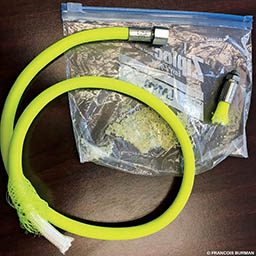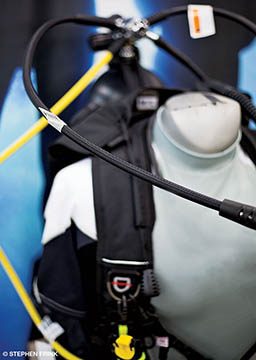DAN® received some excellent responses to the Gear article about hose failures we published in the Winter 2017 issue of Alert Diver. We would like to summarize the comments we received and provide additional perspectives on this very real safety concern.
Some responses were additional examples of regulators that failed because of the yellow “crystals” discussed in that article. Others were reports of degraded hose linings, including one in a rubber (not braided) hose. In this case, the degradation led to audible hissing and, perhaps, leakage of air from the hose. Hissing or leaking air from a rubberized hose can persist for an extended period before the hose fails, but even minor hissing or leaking from a braided hose may rapidly lead to complete hose failure and thus should prompt action.

We received a few questions about what may exacerbate hose failure, factors such as age, sun exposure, oxidation inside the hose and cleaning solutions used. Although cleaning the inside of hoses is uncommon, some readers indicated that they do so using warm, clean water. Please note that if the water contains any microorganisms, this practice could very easily lead to accelerated hose degradation and formation of the yellow crystals. Some repair centers insert the metal end-fittings into ultrasonic baths to remove verdigris and other forms of surface discoloration, but they must ensure that the cleaning solutions used in these baths are sanitary.
In our ongoing effort to learn more about these hose failures, we consulted the manufacturers. A major supplier expressed great concern about the reports and asked that we share as much information with them as possible. It is important to note that some hoses being sold using brand names from reputable hose manufacturers are, in fact, knockoffs.
We should all heed the advice one hose manufacturer gave DAN: Hoses do not last a lifetime, and braided hoses in particular should be replaced every five years — or more often if there is clear abrasion or they have spent extended periods in the tropical sun.

One avid diver, a specialist engineer at a private company in Redmond, Wash., offered to perform a truly useful and greatly appreciated service: thorough testing of low-pressure braided scuba hoses. He subjected a variety of hoses to accelerated aging, and the preliminary finding was that hoses with a thermoplastic polyester-polyurethane (polyester-TPU) lining material decayed during testing. This result is consistent with the hose-failure reports DAN has collected. Hoses made of or lined with thermoplastic polyether-polyurethane (polyether-TPU), on the other hand, did not fail. A well-known European producer of braided hoses, which has always used polyether-TPU, since 2008 has required its materials supplier to certify its polyether-TPU hose linings.
The decay product, a yellow crystalline-looking substance, is softer than it appears and feels waxy when squeezed. We previously referred to this substance as the product of “polymorphic crystallization,” but the reaction in question is actually hydrolysis, which, as its name implies, requires the presence of water. Elevated temperature promotes accelerated degradation or hydrolysis of the polyester-TPU.
It is hard to predict the time required for a polyester-TPU liner to decay, but available information suggests that at 86°F and high humidity, exposed hoses could decay in less than a year.
To reduce the likelihood of such degradation, divers should keep hoses dry when not in use and minimize hoses’ exposure to high temperatures and humidity.
When buying a hose, determine the composition of its lining — you want it to be a polyether-TPU, not a polyester-TPU. If in doubt, do not purchase the hose. Buy your hoses and other life-support equipment from well-known manufacturers that clearly indicate the type of liner material used. Gear manufacturers have been informed about this phenomenon and have carefully investigated their existing suppliers and implemented improved means of materials verification and quality assurance.
Please keep sending us your comments and questions. DAN is committed to providing the diving public with as much technical safety information as possible.
| © Alert Diver — Q3 2017 |